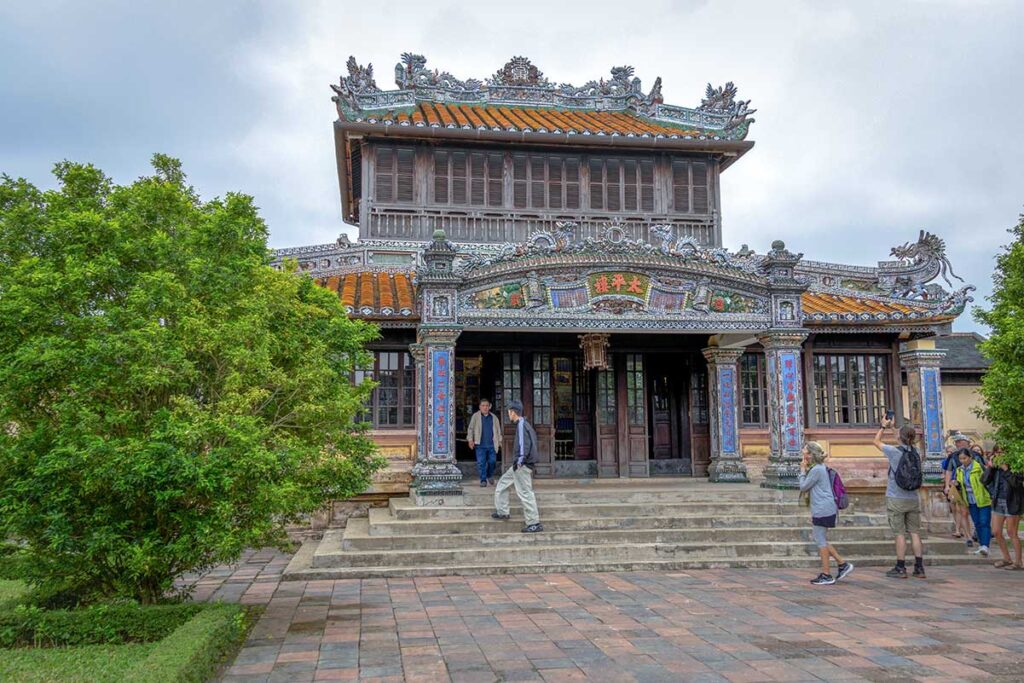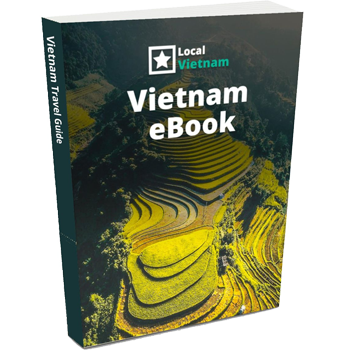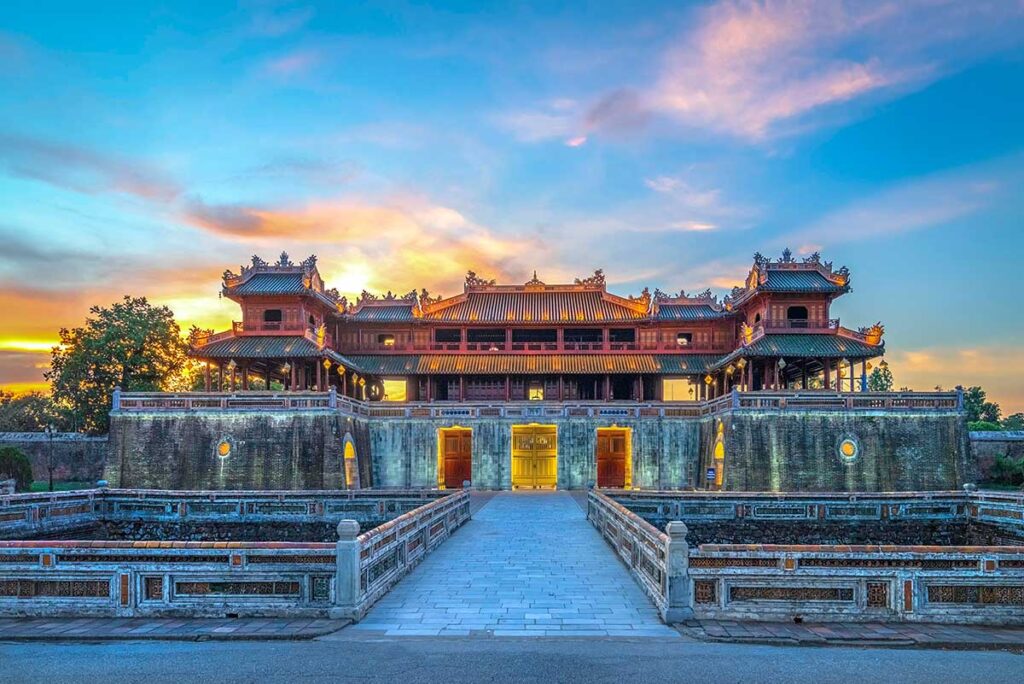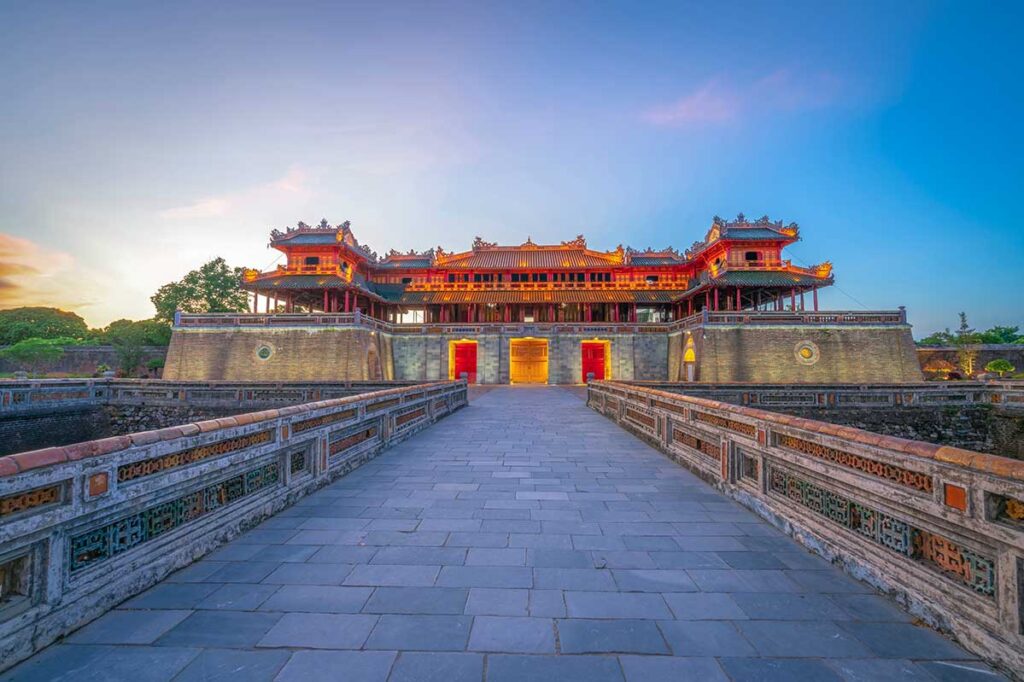What is the Thai Binh Pavilion?
Thai Binh Pavilion is a two-storey royal library and reading retreat built between 1919 and 1921 during Emperor Khai Dinh’s reign. Located in the northeast corner of the Forbidden Purple City, it was designed as a peaceful space for study, poetry, and reflection, surrounded by gardens, ponds, and connecting corridors. Blending traditional Vietnamese architecture with ornate ceramic mosaics, it is one of the few structures in this once-private royal zone to survive the wars of the 20th century.
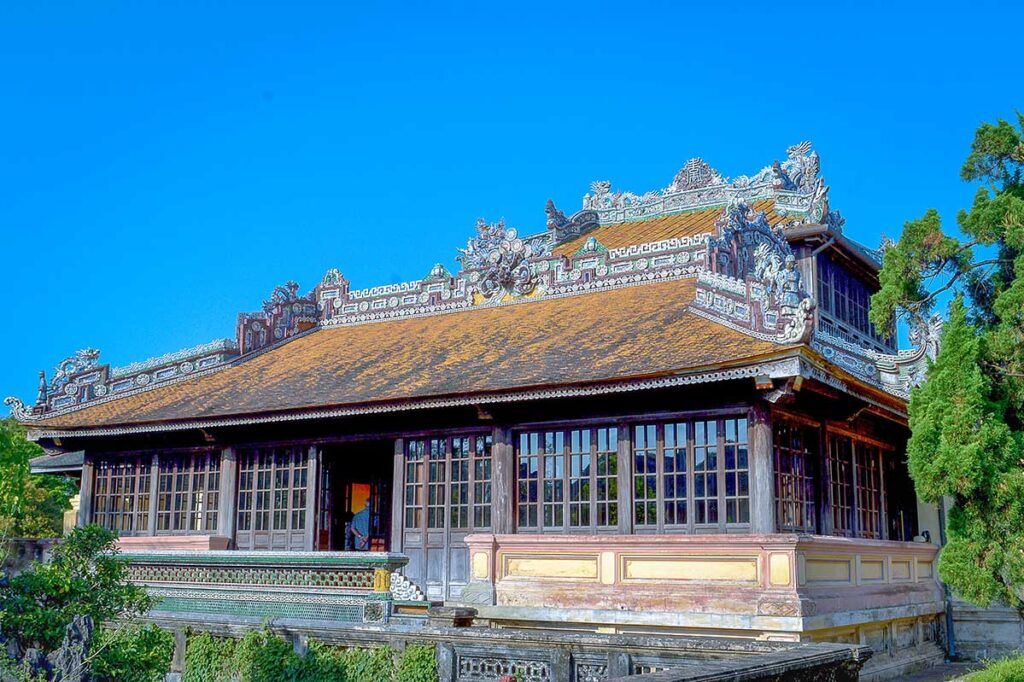
History of Thai Binh Pavilion
Early origins
The site of the current pavilion began as Tri Nhan Mansion, built in 1821 under Emperor Minh Mang in the royal gardens of the Forbidden Purple City. Emperor Thieu Tri later modified the building and renamed it Thanh Thả Thu Lâu, continuing its use as a quiet space for study and contemplation. Under Emperor Dong Khanh in 1887, a new structure was erected here called Thai Binh Ngự Lãm Ngư Lâu, further developing its role as a royal retreat.
Reconstruction under Khai Dinh
Between 1919 and 1921, Emperor Khai Dinh commissioned a complete reconstruction of the pavilion, creating the Thai Binh Pavilion we see today. This version was built in wood and brick, with a two-storey central section and richly detailed roofs decorated with lavish ceramic mosaics. The design reflected Khai Dinh’s taste for blending traditional Vietnamese architecture with refined decorative art.
Survival through wars
When the French reoccupied Hue in 1947, much of the Forbidden Purple City was destroyed or heavily damaged. Thai Binh Pavilion was the only structure in the area to remain intact, escaping both the destruction of that period and later wartime damage. This rare survival makes it an especially valuable link to the Nguyen dynasty’s final years.
Restoration efforts
By the late 20th century, the pavilion showed signs of age and weathering. Major restoration projects took place in the late 1980s and early 1990s, focusing on structural stability and preserving the intricate mosaic work. More recent conservation efforts have ensured that the pavilion remains in good condition, allowing visitors to appreciate both its historical significance and artistic craftsmanship.
Layout of the Imperial City & Location of the Pavilion
Understanding the layout of Hue’s former royal complex makes it easier to picture where Thai Binh Pavilion is located and why it was built in such a peaceful spot.
- Hue Citadel – Outer defensive walls and moat enclosing the royal capital.
- Hue Imperial City – Administrative and ceremonial zone with palaces, temples, and audience halls.
- Forbidden Purple City – Private quarters of the emperor and royal family, off-limits to most.
Location of Thai Binh Pavilion: In the northeast corner of the Forbidden Purple City, next to a pond and rock garden. Connected by covered corridors to Dien Tho Palace and the Royal Theatre.
Highlights of visiting today
Although smaller than some of Hue’s grander landmarks, Thai Binh Pavilion has several distinctive features that make it worth a stop during your visit to the Imperial City.
1. Exterior architecture
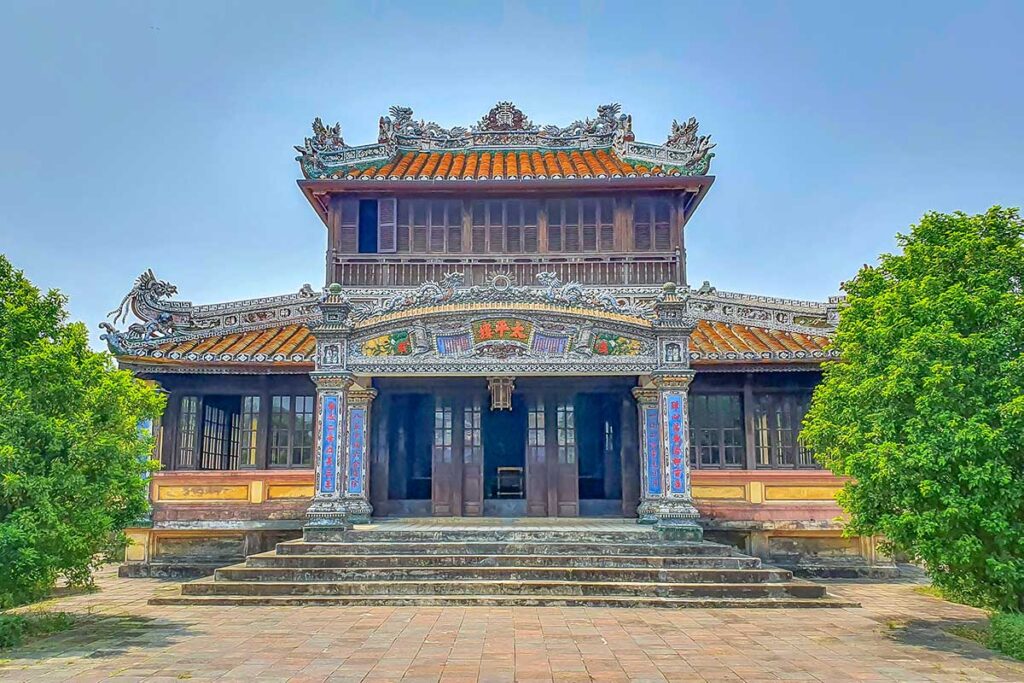
A two-storey wooden structure with a tiled roof in the yin–yang style, accented with yellow glazed elements. The design balances elegance and symmetry, making it stand out among the surrounding garden structures.
2. Mosaic artistry
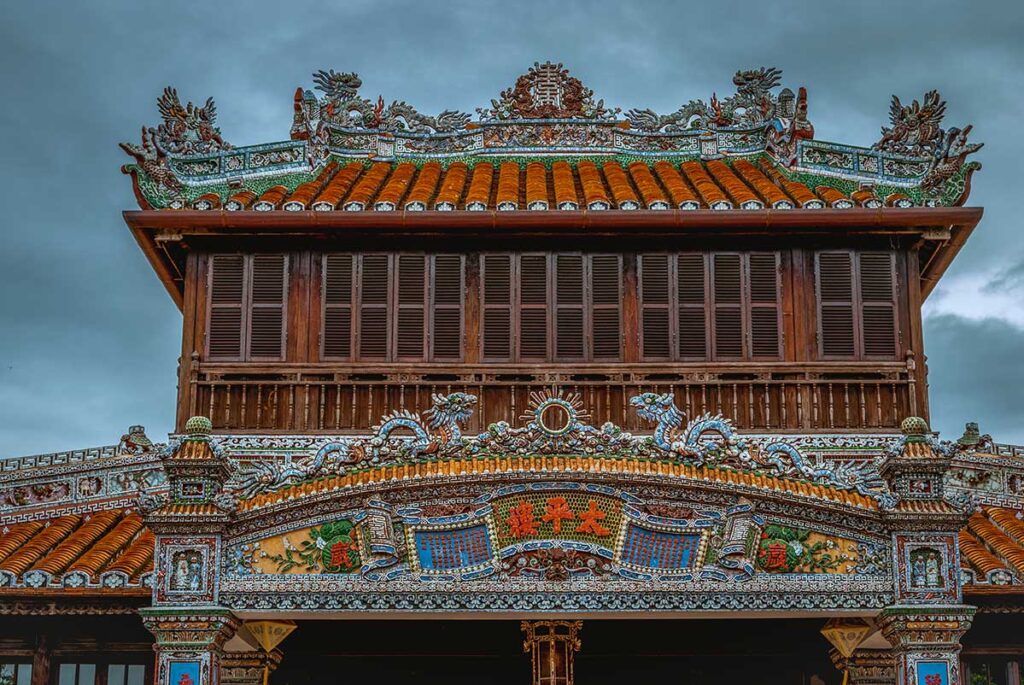
The roof ridges and gables are decorated with intricate ceramic inlays, including the “Five Bats” motif symbolising good fortune, along with dragons, phoenixes, and other mythical creatures. These details catch the light beautifully on sunny days.
3. Gardens & pond
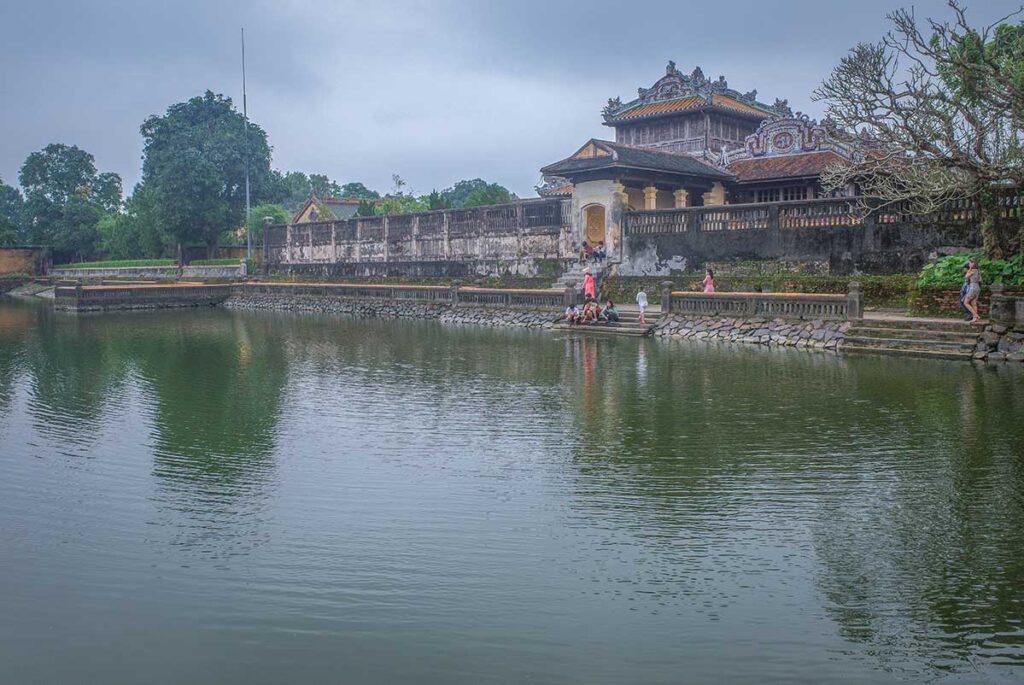
In front of the pavilion is a serene rock garden with bonsai trees and a shallow pond, offering views towards Dien Duong Tam. This setting reflects the Nguyen emperors’ appreciation for harmony between architecture and nature.
4. Interior
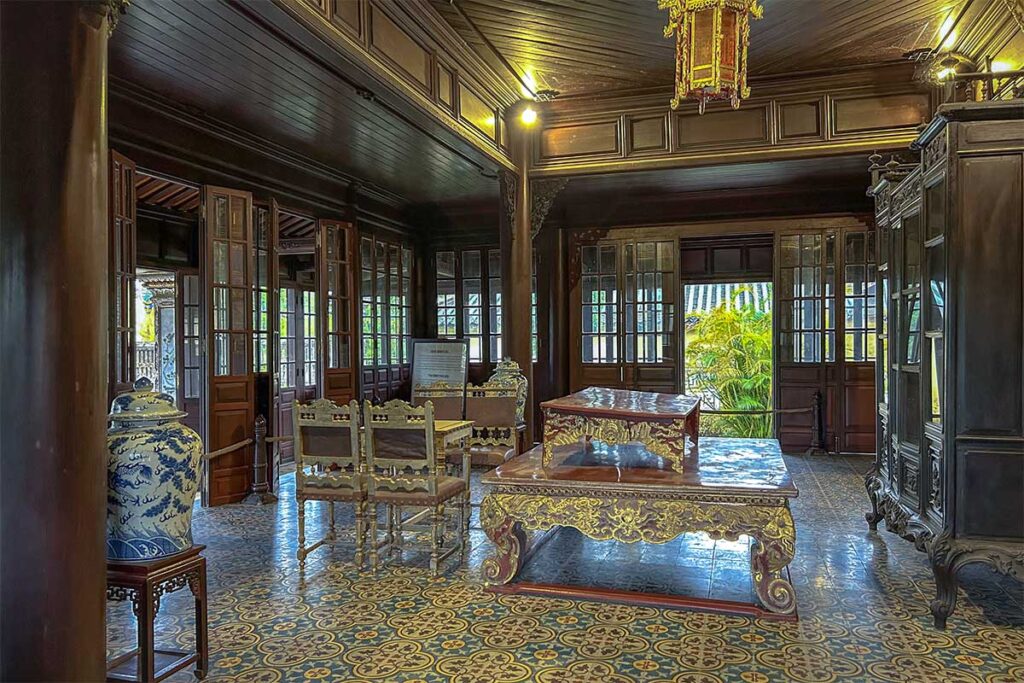
The interior blends traditional Vietnamese craftsmanship with some early 20th-century influences introduced during Emperor Khai Dinh’s reign. Today, part of the space is used as a gift shop, and exhibitions are sometimes displayed here.
5. Cultural events
The pavilion occasionally hosts traditional music performances or special events, such as evening light displays during Hue Festival, which bring a different atmosphere to the historic setting.
Visiting tips & What’s nearby
Tickets & access
Thai Binh Pavilion is included in the general Hue Imperial City ticket. The complex is usually open daily from early morning until late afternoon, but hours can vary slightly with the season.
Tip: Our full-day Hue tour includes Hue Imperial City entry, top highlights, local guide, and hassle-free transfers:
Hue Historical City Tour
- Highlights: Hue Imperial City, royal tombs, Perfume River cruise, Dong Ba Market.
- Options: Small-group tour or private tour
Time needed
When visiting as part of the larger Imperial City, allow about 15–20 minutes here to see both the pavilion and its surrounding gardens. For the entire Imperial City, plan on spending at least 2–3 hours to explore the main palaces, temples, and gardens at a comfortable pace.
Best time to visit
The dry season (March–August) offers the most comfortable weather and better lighting for photography. Morning light works well for capturing the pavilion’s ceramic details.
Nearby sights
Located in the Forbidden Purple City, the pavilion is close to several other key sites, including:
- Dien Tho Palace – residence of the queen mother.
- Royal Theatre (Duyet Thi Duong) – venue for court performances.
- Kien Trung Palace – recently restored imperial residence.
- To Mieu Temple Complex – ancestral temple of the Nguyen emperors.
